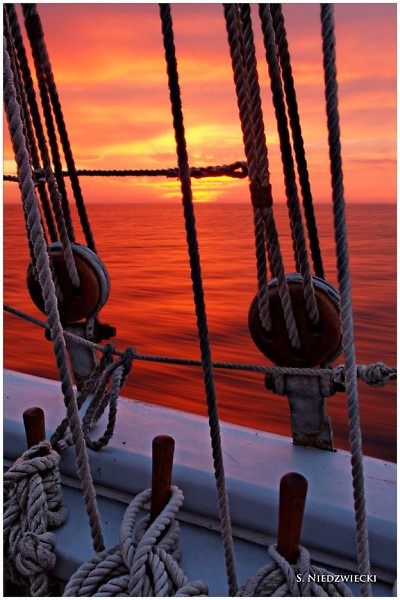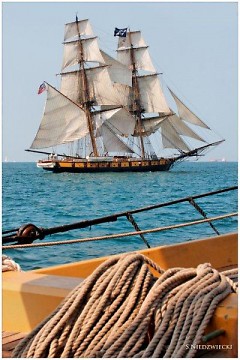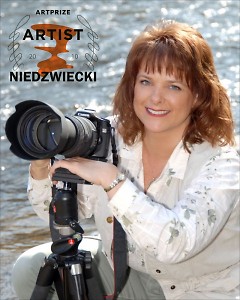In 2006, Stacy Niedzwiecki anticipated the event which would give her an opportunity to combine her passion for photograpy and classic tall sailing ships. The Tall Ships Celebration is held annually in Bay City. Sponsored by the American Sail Training Association (ASTA), which organizes Tall Ships events and co-ordinates sailing and sail training activity and adventures in the Americas, it's mission is to teach young people how to sail. Niedzwiecki knew her photography could be a pathway to securing a spot on a ship. For herself,“this was a unique opportunity for a young mom and a great adventure for a Michigan photographer.”
The photographer, who had no prior sailing experience, boarded the 10 year old sailing vessel S/V Denis Sullivan, an educational schooner and part of Discovery World's outreach based out of Milwaukee, Wisconsin. This ship, a 137-foot replica of a 19th century Great Lakes schooner and a classroom for water education and conservation programs, became her floating residence where she served as a photojournalist and eco-blogger throughout the summer. Documenting her experiences and those of her fellow shipmates, Niedzwiecki traveled alongside a group of 11 high school students who were participating in a Summer Youth Program to teach environmental awareness and a history of schooners on the Great Lakes.
This was not your typical pleasure cruise. Niedzwiecki, the professional crew and volunteers worked long hours, often without much sleep and in humid conditions, while going days without a shower. As a photographer, there were many things to consider when preparing for such a trip.
“Once I was granted permission to go aboard, there was much planning and organizing within a three-week time period,“ Stacy said. “As a digital photographer, there was much consideration as to battery supplies, computer file storage and backup, and the protection and storage of heavy camera gear. A ship can't pull into the local dock so you can replace a camera battery!”
While Niedzwiecki attempted to keep a journal, she found that the images really speak for themselves. As a sailor, she went days without seeing land, experiencing the expansiveness of the Great Lakes. The lakes taught her about flexibility and adaptability (to one's environment), all while capturing the beauty of this large body of water “struggling to maintain it's dignity.”
“As for my voyage, I find it hard to adequately describe in words," she said. "Capturing memories in photographic form is my strongest suit. Therefore, I will allow the images to serve as a witness to my time spent on our Great Lakes. I'm currently going through the task of sorting through 4500 images to pull the best examples of what the journey meant to me.”
Niedzwiecki's journey into the field of photography has also evolved through a sense of environmental adaptability. Growing up an only child, in a small town in upstate New York, and raised by grandparents who grew their own food and farmed the land, she experienced a culture shock when moving to Kentwood and an environment of “upper class.” It's no surprise that she has been drawn to capturing the simplicity in the natural beauty of Michigan that surrounds her.
After attending Kendall College of Art and Design, first as an illustration major, and then moving into graphic design, she spent the next 25 years doing graphic design work (both full time and freelance), essentially being told, or assigned, what to do. Niedzwiecki needed an outlet for her own creativity. She had always lugged a camera around during her time at Kendall, so encouraged by a friend, she purchased her first point and shoot Olympus digital camera and found herself photographing details of bugs and flowers in her garden. Shortly after, fueled by her young colicky son, Lucas, she would load him and her equipment into the car and drive around unnoticed back roads with the windows down. The rides in the car soothed the child and allowed her to pursue her passion at the same time. As a busy graphic artist and full-time mother, she found herself driving “to find peace” along the Michigan back roads, searching for images that captured it's essence visually.
Niedzwiecki said, “Photography found me. I didn't realize that driving the back roads to find peace would allow other people to feel the same.”
Stacy has mastered the ability to capture an image that represents this emotion. In a still male-dominated field, it is unusual to find a woman venturing into the woods and wilderness on her own. Stacy makes a comparison of nature photography to hunting, only with electronic equipment. She is entirely self-taught and her process instinctual. However, she insists, photography need not require fancy expensive equipment. Having the basis of graphic design and a knowledge of color correction, composition and Photoshop work, she has what many beginning photographers struggle to learn. She also sites the need to have a good relationship with a photo lab and much of what she has learned has come from her experience of pushing the limits of her knowledge base.
As a photographer, Niedzwiecki has earned much recognition for her work throughout West Michigan over the years, while also maintaining a practice as a visual communications specialist and owner of Niedzwiecki Creative Solutions. Her big break came when a volunteer, at Robinette's Orchard gallery where she shows her work, and who also happened to sit on the Advisory Board for Spectrum Health's Lemmen-Holton Cancer Pavilion, presented her work to the board. Sixty-four of her images, many selected from a two-week residency at Sleeping Bear Dunes, were chosen to become part of the Pavilion's permanent collection and subsequently, are now featured in her first book effort – Healing Images, published in March 2010.
While Niedzwiecki states she is “not an activist by any means," her work clearly demands otherwise. As she experienced the pristine areas of the lake shore that are still untouched, she began to realize that this is our area to enjoy. Her message to those who view her exhibition would be, “Don't mess up the Great Lakes. Help keep them clean for those who live here – for those who don't – this is what we have here too. I want to highlight all that Michigan has to offer.”
Niedzwiecki wants people to understand that each one of us has an impact on the Great Lakes. To illustrate this, she brings the ships into focus while juxtaposing them with statistics and figures about the Great Lakes. By presenting them graphically through the interest of the ships, she creates a visual continuation of the festival. The artist has made available a map of the route that the ship took as well as copies of the Great Lakes United Green Book, an introduction to the Great Lakes and the challenges it faces, available to viewers.
Niedzwiecki was also a participant in ArtPrize 2009, displaying her work at San Chez Bistro. This year her focus on securing a venue was to find a more formal setting, such as a church, with a quiet space for contemplation. Her installation, titled “Great Lakes – Great Ships – Great Concerns,” will be displayed until October 9 at Immanuel Lutheran Church, a Gothic church located at the corner of Michigan and Division. A curved glass wall will serve as a backdrop to her images.
“The wall is shaped like a 'wave' and had the reflective qualities of water," she said. "It will serve as an excellent background to my Great Lakes and tall ship images.”
Of ArtPrize, the artist sees this as being “the biggest networking event of your life.” This year she is not as concerned about participating for the vote.
“Ultimately, I am shooting for me,” she said.
Fortunately, other people feel the same about her imagery and subject matter.
"I've always done what I've wanted to do, regardless of what people think,” she said.
Niedzwiecki has bigger visions for her work and sees a multi-purpose to this project that has consumed her life for six weeks. By highlighting the beauty of Michigan and it's vital water resources, she drives home the message that, “We love our Great Lakes.”
The Rapidian, a program of the 501(c)3 nonprofit Community Media Center, relies on the community’s support to help cover the cost of training reporters and publishing content.
We need your help.
If each of our readers and content creators who values this community platform help support its creation and maintenance, The Rapidian can continue to educate and facilitate a conversation around issues for years to come.
Please support The Rapidian and make a contribution today.



